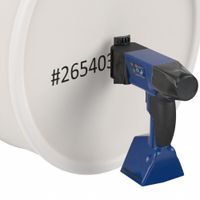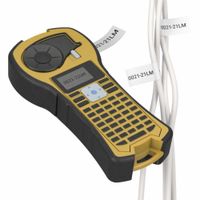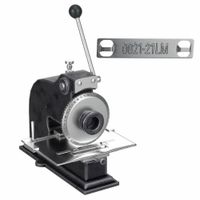Call +(254) 703 030 000 / 751 483 999 / 721 704 777
- Home
- Safety
- Signs Facility Identification Products
- Label Printers
.....Read More
Frequently Asked Questions
What are the best label printers for industrial use?
The best label printers for industrial use are designed to handle high-volume printing with durability and efficiency. Here are some top options:
1. **Zebra ZT410**: Known for its robust performance, the Zebra ZT410 offers high-speed printing and supports a wide range of label types. It features a metal frame and bi-fold door, making it durable and easy to fit in tight spaces. It also supports RFID encoding.
2. **Honeywell PM43**: This printer is ideal for demanding environments, offering fast print speeds and a user-friendly interface. It supports multiple connectivity options and is known for its reliability and ease of integration into existing systems.
3. **Sato CL4NX**: The Sato CL4NX is praised for its intuitive design and high-quality print output. It supports a wide range of media and has a color LCD display for easy operation. Its tool-less maintenance and robust construction make it suitable for industrial settings.
4. **TSC MX240P**: This printer is designed for heavy-duty applications, offering fast print speeds and high-resolution printing. It features a rugged design and supports a variety of media types, making it versatile for different industrial needs.
5. **Intermec by Honeywell PX4i**: Known for its flexibility and scalability, the PX4i offers high-performance printing with a modular design. It supports smart printing capabilities, allowing for standalone operation without a PC.
6. **Brother TJ-4522TN**: This printer is designed for high-volume label printing with a focus on reliability and cost-efficiency. It offers fast print speeds and supports a wide range of connectivity options, making it easy to integrate into existing workflows.
These printers are selected based on their durability, speed, print quality, and ease of integration, making them suitable for various industrial applications.
How do label printers work for creating custom tags and signs?
Label printers work by using various printing technologies to produce custom tags and signs. The most common types are thermal transfer and direct thermal printers.
Thermal transfer printers use a heated printhead to transfer ink from a ribbon onto the label material. This method is durable and suitable for labels that need to withstand harsh conditions, such as exposure to chemicals or extreme temperatures. The ribbon acts as a buffer, ensuring the printhead lasts longer.
Direct thermal printers, on the other hand, use heat-sensitive paper that darkens when heated by the printhead. This method doesn't require ink, toner, or ribbons, making it cost-effective. However, the labels are less durable and can fade over time, especially when exposed to heat or sunlight.
Both types of printers are controlled by software that allows users to design custom labels. This software can include templates, fonts, barcodes, and graphics, enabling the creation of personalized tags and signs. Users can input data manually or import it from databases, spreadsheets, or other sources.
The label material is fed through the printer, where the printhead applies heat to create the desired text and images. The finished labels are then cut to size, either manually or automatically, depending on the printer model.
Label printers can handle various materials, including paper, polyester, vinyl, and polypropylene, allowing for versatility in applications. They are used in industries like retail, manufacturing, logistics, and healthcare for tasks such as product labeling, asset tracking, and safety signage.
Overall, label printers provide a flexible and efficient solution for creating custom tags and signs, catering to diverse needs across different sectors.
What materials can label printers print on?
Label printers can print on a variety of materials, each suited for different applications and environments. Common materials include:
1. **Paper**: The most widely used material, suitable for general-purpose labeling. It is cost-effective and available in various finishes like matte, semi-gloss, and high-gloss.
2. **Polyester (PET)**: Known for its durability, polyester labels are resistant to water, chemicals, and UV light, making them ideal for outdoor use and harsh environments.
3. **Polypropylene (PP)**: Similar to polyester but more flexible, polypropylene labels are resistant to moisture and chemicals, often used for product packaging and labeling.
4. **Vinyl**: Highly durable and flexible, vinyl labels are waterproof and resistant to fading, making them suitable for outdoor applications and industrial settings.
5. **Polyethylene (PE)**: Known for its flexibility and resistance to moisture, polyethylene labels are often used for squeezable containers and applications requiring a conformable label.
6. **Polyimide**: Used in high-temperature environments, such as electronics manufacturing, polyimide labels can withstand extreme heat and are often used for circuit board labeling.
7. **Tyvek**: A synthetic material made from high-density polyethylene fibers, Tyvek is tear-resistant and waterproof, commonly used for wristbands and tags.
8. **Fabric**: Used for clothing labels, fabric materials like satin, cotton, and nylon are durable and can withstand washing and dry cleaning.
9. **Metallic Foil**: Provides a shiny, reflective surface, often used for decorative labels and premium product packaging.
10. **Thermal Transfer Ribbon**: Used in thermal transfer printers, these ribbons are coated with wax, resin, or a combination, transferring ink onto various substrates.
Label printers can accommodate these materials depending on the printer type (thermal, inkjet, laser) and the intended application, ensuring versatility across industries.
How do I choose the right label printer for my needs?
1. **Identify Your Needs**: Determine the volume of labels you need to print, the size and type of labels, and the printing speed required. Consider whether you need color printing or if black and white suffices.
2. **Printer Type**: Choose between direct thermal and thermal transfer printers. Direct thermal printers are suitable for short-term labeling, while thermal transfer printers are better for long-lasting labels.
3. **Resolution**: Higher resolution (measured in DPI) is essential for printing detailed graphics or small text. Standard resolution is 203 DPI, but 300 DPI or higher is recommended for high-quality prints.
4. **Connectivity**: Ensure the printer supports your preferred connection method, such as USB, Ethernet, Wi-Fi, or Bluetooth, depending on your setup and mobility needs.
5. **Compatibility**: Check if the printer is compatible with your operating system and labeling software. Some printers come with proprietary software, while others support third-party applications.
6. **Durability and Environment**: Consider the printer's durability and the environment it will be used in. Industrial settings may require rugged printers, while office environments might need compact, quieter models.
7. **Cost**: Factor in the initial cost of the printer and the ongoing cost of consumables like labels and ribbons. Balance between upfront investment and long-term operational costs.
8. **Brand and Support**: Opt for reputable brands known for reliability and good customer support. Check warranty terms and availability of service centers.
9. **User Reviews and Recommendations**: Research user reviews and seek recommendations to gauge real-world performance and reliability.
10. **Future Needs**: Consider potential future needs, such as scalability or additional features, to ensure the printer remains useful as your business grows.
Can label printers be used for outdoor applications?
Yes, label printers can be used for outdoor applications, but several factors must be considered to ensure durability and effectiveness. The key is selecting the right type of label printer and materials that can withstand outdoor conditions such as UV exposure, moisture, temperature fluctuations, and abrasion.
1. **Printer Type**: Thermal transfer printers are often preferred for outdoor labels because they use a ribbon to transfer ink onto the label material, creating a more durable print that can resist fading and smudging.
2. **Label Material**: The choice of label material is crucial. Synthetic materials like polyester, polypropylene, and vinyl are commonly used for outdoor labels due to their resistance to water, chemicals, and UV light. These materials are more durable than paper labels, which can degrade quickly in outdoor environments.
3. **Adhesive**: The adhesive must be strong enough to adhere to various surfaces and withstand environmental conditions. Permanent adhesives are typically used for outdoor labels to ensure they remain affixed over time.
4. **Ink and Ribbon**: For thermal transfer printers, using resin-based ribbons is recommended for outdoor applications. Resin ribbons provide high resistance to environmental factors and ensure the print remains legible.
5. **Lamination and Coatings**: Applying a laminate or protective coating can further enhance the durability of outdoor labels by providing an additional barrier against the elements.
6. **Environmental Considerations**: Consider the specific environmental conditions the labels will face, such as extreme temperatures, humidity, or exposure to chemicals, and choose materials and printing methods accordingly.
By carefully selecting the appropriate printer, materials, and printing techniques, label printers can effectively produce labels suitable for outdoor applications, ensuring longevity and readability in challenging conditions.
What are the differences between handheld and embossing label printers?
Handheld label printers and embossing label printers serve the purpose of creating labels but differ significantly in their design, functionality, and applications.
Handheld label printers are electronic devices that allow users to create labels using a built-in keyboard and display. They are typically battery-operated, portable, and can print on various label materials, including paper, plastic, and fabric. These printers use thermal transfer or direct thermal printing technology, which provides high-quality, durable labels. Handheld label printers often come with features like multiple font styles, sizes, symbols, and the ability to print barcodes. They are ideal for dynamic environments such as warehouses, retail, and offices where quick, on-the-go labeling is required.
Embossing label printers, on the other hand, are manual devices that create labels by pressing characters into a tape, usually made of plastic or metal, to form raised letters. This process does not require electricity or batteries, making embossing label printers highly durable and reliable in various conditions. The labels produced are typically more resistant to environmental factors like moisture and chemicals, making them suitable for outdoor or industrial use. However, embossing label printers offer limited customization options, usually restricted to a single font and size, and do not support complex graphics or barcodes.
In summary, handheld label printers offer versatility, speed, and advanced features suitable for modern, fast-paced environments, while embossing label printers provide durability and simplicity, ideal for rugged conditions and basic labeling needs.
How do I maintain and troubleshoot a label printer?
To maintain and troubleshoot a label printer, follow these steps:
1. **Regular Cleaning**: Clean the print head with isopropyl alcohol and a lint-free cloth to remove dust and adhesive residue. Clean the platen roller and media sensors to ensure smooth operation.
2. **Use Quality Supplies**: Use high-quality labels and ribbons to prevent jams and ensure clear printing. Store them in a cool, dry place to avoid moisture damage.
3. **Calibration**: Regularly calibrate the printer to ensure accurate label alignment. Follow the manufacturer's instructions for calibration procedures.
4. **Firmware Updates**: Keep the printer's firmware updated to benefit from the latest features and bug fixes. Check the manufacturer's website for updates.
5. **Check Connections**: Ensure all cables are securely connected. For network printers, verify the network settings and connectivity.
6. **Error Codes**: Refer to the user manual for error codes and their solutions. Common issues include paper jams, ribbon errors, and sensor faults.
7. **Software Settings**: Verify that the printer settings in the software match the label size and type. Incorrect settings can cause misalignment and print errors.
8. **Test Prints**: Run test prints to check for print quality issues. Adjust the print darkness and speed settings if necessary.
9. **Replace Worn Parts**: Regularly inspect and replace worn parts like the print head and platen roller to maintain print quality.
10. **Professional Servicing**: Schedule regular maintenance with a professional technician to address complex issues and extend the printer's lifespan.
By following these steps, you can ensure your label printer operates efficiently and troubleshoot common issues effectively.



